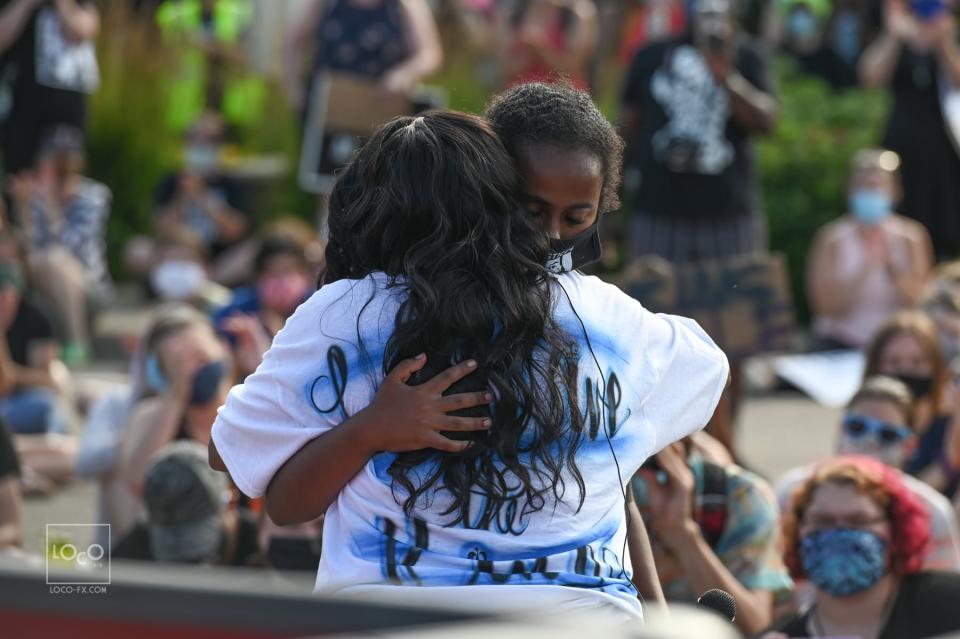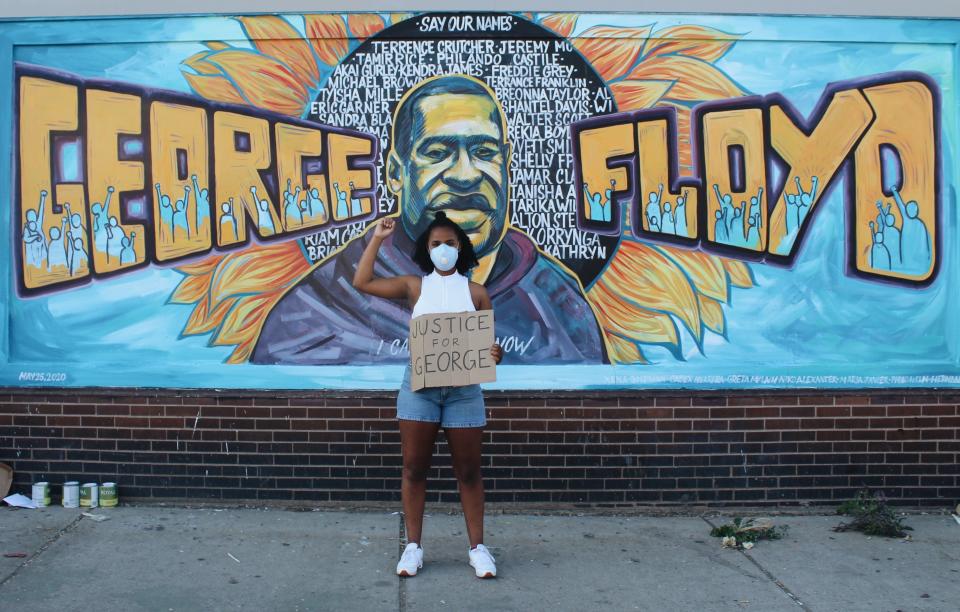Philando Castile Is Memorialized in a Mural, Thanks to Local Teen Activist
- Oops!Something went wrong.Please try again later.
Semhar Solomon isn’t satisfied with the idea that she won’t see change in her lifetime. In fact, the 17-year-old Minnesotan has effected major change in the five years since she first felt compelled to take a public stand. That was in 2016, shortly after Philando Castile, a 32-year-old Black man, was killed by police in a nearby city. At just 12 years old, Semhar joined hundreds of others to protest his death in her hometown of St. Anthony, a small, mostly white Minneapolis suburb that employed the police officer who fatally shot Castile (and was ultimately acquitted for his killing).
Fast-forward to May 2020, when George Floyd was murdered by Minneapolis police officer Derek Chauvin in a video seen around the world. The unrest that followed left the Twin Cities metro area literally in shambles, with buildings burned to the ground, entire neighborhoods devastated, and countless people in need of groceries and basic supplies. Semhar again felt the urge to do something. So she organized a series of donation drives throughout the summer, raising $10,000 and delivering 50 carloads of goods to the hardest-hit areas.
“My activism started because I wanted to see change happen,” Semhar tells Teen Vogue. “The donation drive was the first form of activism I organized, and I started that at five in the morning. I just woke up and thought, I have to do this. And people started showing up.”
Not only did people show up with donations, they showed up to help however they could, whether that meant providing graphic design services, spreading the word, or hosting drop-off sites at their own homes. Encouraged by the success, Semhar decided to continue down her activist path.
“After George Floyd was murdered, I went to a lot of protests and I heard a speaker say, ‘Bring this activism back to your communities,’” she recalls. “It was like, What can I do to make this revolution happen? I need to be the changemaker. I have the power. That’s when I started planning the Philando Castile rally.”
Four years after attending her first protest, Semhar was organizing another in the same spot in front of St. Anthony's city hall. Although she didn’t have any experience planning such an event, she produced impressive results: Some 300 people showed up to mark the anniversary of Castile’s death, to hear from his mother, Valerie, and to listen to stories of racial profiling.
“What scares most people [with organizing] is that they don’t know where to start,” Semhar says. “Just start; just do something. Whatever you want to see, make it a reality. Make a list of things you need to get. Make a list of people you need to connect with. Just make it happen.”

But she wanted to have an impact that would last beyond the one rally. She wanted to prompt an ongoing conversation in her community that people couldn’t turn away from. So Semhar conceived of a mural to honor Castile, to be painted outside St. Anthony's city hall, which also houses the police department.
“We hadn’t really talked about Philando Castile in St. Anthony as a whole since he was murdered — and even then, that was [only] if you wanted to talk about it,” Semhar explains. “The idea of the mural was to make that conversation no longer optional. You’re seeing the face of a Black man in a predominantly white city. That’s going to stir up a conversation, which was the whole goal: to keep Philando Castile’s name and memory alive while also addressing police brutality in Minnesota.”
On July 14, 2020, Semhar went before the city council to make her case. After more than an hour of testimony from residents, the proposal was voted down 4–1. Among the reasons cited: the precedent it would set, the division it could cause, the affront to police. Council member Bernard Walker, a Black man, cast the single supporting vote.
Semhar was disheartened by the decision, but her determination — and the support of her community — kept her going. Even if the city wasn’t in favor of the mural, the people of St. Anthony were. She was inundated with offers to help turn a plywood mural she and her friends had created for the rally into something more permanent. Residents offered to take turns proudly displaying it on their private property. Today, the traveling artwork spends brief stints in high-traffic areas around town, complete with lighting and flowers. At the end of the summer, Semhar intends to gift it to Valerie Castile to be placed at the forthcoming Philando Castile Peace Garden at the site where he was killed.
Although it has taken on a different form, the mural is serving the purpose Semhar envisioned. “It’s bringing about that conversation, keeping Philando Castile’s name alive, causing people to talk about racism and police brutality,” she says. “It truly became a community project and effort. Everyone has a different part in the movement.”
Semhar has been an inspiration in her community and her school too. In April, she organized a walkout as part of a statewide movement to protest racial injustice after the police killing of Daunte Wright in nearby Brooklyn Center. Then in May, she organized a moment of silence on the one-year anniversary of Floyd’s death. Both events drew around 150 students, some as young as 12, the age Semhar was at her first protest.
When Chauvin was convicted for Floyd’s murder, Semhar rejoiced. “That day was a celebration,” she says. “It gave me a glimpse of what justice looks like. I had mentally prepared for everything except him being convicted on all three charges. We all know how the system works; it’s not meant to benefit Black bodies. But it was like, This is why we fight. This is why we protest.”

For Semhar, the change over the past year has been exceptional. Where there was silence, there is now action. Case in point: After the walkout, middle schoolers wrote phrases like “Black Lives Matter” and “Say his name” in chalk on the pavement outside her school for a solid month. “Seeing little things like that is so heartwarming,” she explains. “I never would have expected that a year ago.” Semhar has also changed throughout her senior year of high school, evolving from protest participant to experienced activist.
This summer, she’s organizing a celebration commemorating Castile’s life to coincide with the five-year anniversary of his death. And in the fall, she’ll head to UCLA. Although Semhar is undecided about her major, one thing’s for sure: “My activism is coming with me,” she says. “My megaphone is coming with me. The revolution is coming with me. The change is coming with me.”
Want more from Teen Vogue? Check this out: The History of Policing in the United States Is About Controlling Black Lives
Stay up-to-date with the politics team. Sign up for the Teen Vogue Take!
Originally Appeared on Teen Vogue

